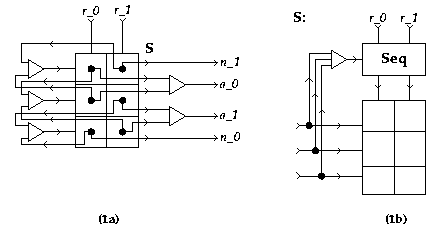
[Zoom|FIG]
XDI state graph for a Nacking Arbiter:

[Zoom|FIG]
The state graph of a Nacking Arbiter is rather more complicated than that of most other systems. It is best compared to the state graph of a Mutual-Exclusion Element, which lacks the nack outputs but is otherwise very similar. We have used the same numbering scheme for both state graphs. It appears that states 1, 3, 4, 5, 7, 11, 12, and 14 have been split into related but distinct states.
In state 5, there is a choice between granting one of the two requesting parties and nacking the other. Once the nack arrives at the environment, subsequent requests by the nacked party are always nacked, also if the grant did not yet arrive at the environment (there is no more choice). This gives rise to states 1', 4', 5', and 5''.
The distinction between states 4 and 4'', and also between 5 and 5''' is in the n_1 arrows. The difference between states 5 and 5''' is that an n_1 signal in state 5''' may still be a response to an earlier request when the resource was not available. Similarly, the distinction between states 1 and 1'', and also between 5 and 5'''' is in the n_0 arrows.
The distinction between states 12 and 12' is in the n_0 arrows. The distinction between states 7 and 7' is in the n_1 arrows. The difference between states 14 and 14' is explained by the fact that the last party to have had `access to the critical section' certainly cannot be nacked upon a subsequent request; the other party might.
Verdect
Specification in Verdect:
define NAK( r0?, a0!, n0!, r1?, a1!, n1! ) =
|[ x0, x1, y0, y1, z0, z1 ::
pref *[ r0?; (x0; a0!; r0?; y0; a0! | z0; n0!) ]
|| pref *[ r1?; (x1; a1!; r1?; y1; a1! | z1; n1!) ]
|| pref *[ x0; *[z1]; y0 | x1; *[z0]; y1 ]
]|
end
Also available through this link
DI Algebra
Properties
XDI Report.
The roles of the subscripts 0 and 1 can be interchanged
A Nacking Arbiter is not output deterministic, since there is an output choice in states 5, and 5''', 5''''. The output nondeterminism is dynamic.
Implementations
DI Decompositions
- According to
Josephs90b
the
Nacking Arbiter specified by the algebraic expression above
can be implemented by a
state machine using
a sequencing component S,
an I-Wire,
six Forks and
five Merges, see figure 1a; component S
can be decomposed further into
a Sequencer (Seq),
an mxn-Decision Call and
a 3-Merge, see figure 1b. (NOT equ):

[Zoom|FIG]
Using Boolean Gates
No information available
Using Transistors
No information available
Generalizations
No information available
Miscellaneous
No information available
References
Last modified at Fri Nov 20 10:13:46 1998
Encyclopaedia of Delay-Insensitive SystemsCopyright © 1995-1998 Tom Verhoeff / Tom.Verhoeff@acm.org